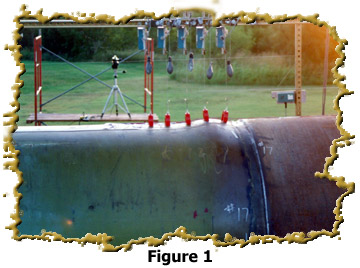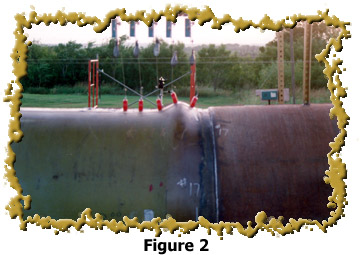

Repair Sleeve Testing and Validation
 Full encirclement repair sleeves are very often used for repairing
pipelines. When pipelines are externally corroded or damaged, repair
sleeves provide the hoop stress reinforcement necessary to allow the
pipeline to continue operating at high pressures. So the good news is
that sleeves can be added to repair a damaged pipeline. Unfortunately,
the bad news is that sleeves have to end somewhere. If a buried
pipeline with an added sleeve is subject to differential soil settlement
or ground motion, the ends of the sleeve generate a substantial
discontinuity in the bending stiffness of the pipeline cross section.
Such discontinuities may concentrate bending deformations with the
potential to either wrinkle the carrier pipe or damage the pipe-sleeve
welds.
Full encirclement repair sleeves are very often used for repairing
pipelines. When pipelines are externally corroded or damaged, repair
sleeves provide the hoop stress reinforcement necessary to allow the
pipeline to continue operating at high pressures. So the good news is
that sleeves can be added to repair a damaged pipeline. Unfortunately,
the bad news is that sleeves have to end somewhere. If a buried
pipeline with an added sleeve is subject to differential soil settlement
or ground motion, the ends of the sleeve generate a substantial
discontinuity in the bending stiffness of the pipeline cross section.
Such discontinuities may concentrate bending deformations with the
potential to either wrinkle the carrier pipe or damage the pipe-sleeve
welds.
The project included the analytical evaluation of repair sleeved designs
used in the Trans-Alaska Pipeline System (TAPS) for Alyeska Pipeline
Service Company. Finite element analysis of repair sleeve
configurations was conducted including wrinkling capacity evaluation and
weld fracture assessment. Simulations of field settlement demand
scenarios were followed by design and planning of an experimental
evaluation of pipe-sleeve configurations.

In order to validate the analytical work, SSD planned and directed a
series of full-scale tests of fillet welded pipe-sleeve configurations.
The test, which were conducted on 48-inch diameter by 0.462-inch thick
pipe sections, included the application of internal pressure and axial
forces to simulate fully restrained conditions. Lateral loading was
then applied through four-point bending up to, and beyond wrinkling of
the specimens. Examples of the wrinkled pipe from these tests are shown
in Figures 1 and 2.
At the completion of the experimental program, analytical correlation
studies were also conducted to calibrate PIPLIN analysis models. This
effort lead to the development of a wrinkling segment analysis method
that allows for accurate prediction of pipe wall wrinkling of the TAPS
pipeline, with an without sleeves. The wrinkling segment method
involves the user of nonlinear anisotropic material stress-strain
relationships and pipeline models which include large displacement
effects and strength loss. The results from this method are practical
because they can be used in conjunction with a pipeline monitoring
program based on "smart" geometry pigs.
Home |
Consulting Services |
Project Profiles |
Key Personnel |
Contact Us
SSD, Inc. · 10643 Professional Circle, Suite A · Reno, NV 89521 · Phone (775)-770-1126 · Fax (775)-770-1129 · info@ssdinc.com
Please feel free to
contact SSD for
more information on any of our services.
Copyright ©2011 SSD, Inc. All rights reserved
 Full encirclement repair sleeves are very often used for repairing
pipelines. When pipelines are externally corroded or damaged, repair
sleeves provide the hoop stress reinforcement necessary to allow the
pipeline to continue operating at high pressures. So the good news is
that sleeves can be added to repair a damaged pipeline. Unfortunately,
the bad news is that sleeves have to end somewhere. If a buried
pipeline with an added sleeve is subject to differential soil settlement
or ground motion, the ends of the sleeve generate a substantial
discontinuity in the bending stiffness of the pipeline cross section.
Such discontinuities may concentrate bending deformations with the
potential to either wrinkle the carrier pipe or damage the pipe-sleeve
welds.
Full encirclement repair sleeves are very often used for repairing
pipelines. When pipelines are externally corroded or damaged, repair
sleeves provide the hoop stress reinforcement necessary to allow the
pipeline to continue operating at high pressures. So the good news is
that sleeves can be added to repair a damaged pipeline. Unfortunately,
the bad news is that sleeves have to end somewhere. If a buried
pipeline with an added sleeve is subject to differential soil settlement
or ground motion, the ends of the sleeve generate a substantial
discontinuity in the bending stiffness of the pipeline cross section.
Such discontinuities may concentrate bending deformations with the
potential to either wrinkle the carrier pipe or damage the pipe-sleeve
welds.


